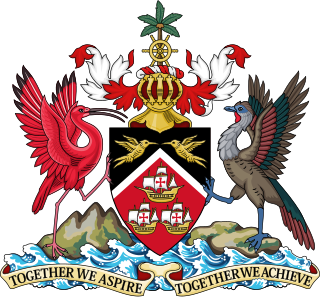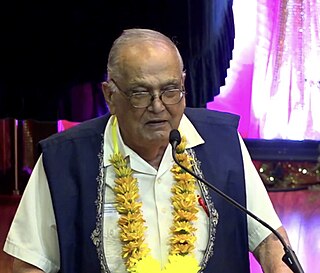This article is about the demographic features of the population of Trinidad and Tobago, including population density, ethnicity, education level, health of the populace, economic status, religious affiliations and other aspects of the population.
The music of Trinidad and Tobago is best known for its calypso music, soca music, chutney music, and steelpan. Calypso's internationally noted performances in the 1950s from native artists such as Lord Melody, Lord Kitchener and Mighty Sparrow. The art form was most popularised at that time by Harry Belafonte. Along with folk songs and African- and Indian-based classical forms, cross-cultural interactions have produced other indigenous forms of music including soca, rapso, parang, chutney, and other derivative and fusion styles. There are also local communities which practice and experiment with international classical and pop music, often fusing them with local steelpan instruments.
The music of the Lesser Antilles encompasses the music of this chain of small islands making up the eastern and southern portion of the West Indies. Lesser Antillean music is part of the broader category of Caribbean music; much of the folk and popular music is also a part of the Afro-American musical complex, being a mixture of African, European and indigenous American elements. The Lesser Antilles' musical cultures are largely based on the music of African slaves brought by European traders and colonizers. The African musical elements are a hybrid of instruments and styles from numerous West African tribes, while the European slaveholders added their own musics into the mix, as did immigrants from India. In many ways, the Lesser Antilles can be musically divided based on which nation colonized them.

Holi is a popular ancient Hindu festival, originating from the Indian subcontinent. It is celebrated predominantly in India, but has also spread to other areas of Asia and parts of the Western world through the diaspora from the Indian subcontinent. Holi is popularly known as the Indian "festival of spring", the "festival of colours", or the "festival of love". The festival signifies the victory of good over evil. It signifies the arrival of spring, the end of winter, the blossoming of love, and for many a festive day to meet others, play and laugh, forget and forgive, and repair broken relationships. The festival also celebrates the beginning of a good spring harvest season. It lasts for a night and a day, starting on the evening of the Purnima falling in the Vikram Samvat Calendar, in the Hindu calendar month of Phalguna, which falls around middle of March in the Gregorian calendar. The first evening is known as Holika Dahan or Chhoti Holi and the following day as Holi, Rangwali Holi, Dhuleti, Dhulandi, or Phagwah.
Chutney music is an Indo-Caribbean genre of music that developed in the southern Caribbean, and is popular in Trinidad and Tobago, Guyana, Suriname, Jamaica, other parts of the Caribbean, Fiji, Mauritius, and South Africa. It is a mixture of Bhojpuri music, and local (Caribbean) music. Chutney music emerged mid-20th century and reached a peak of popularity during the 1980s. Initially lyrics were religious in nature and typically sung by females. Several sub-genres have developed.
The music of Guyana encompasses a range of musical styles and genres that draw from various influences including: Indian, Latino-Hispanic, European, African, Chinese, and Amerindian music. Popular Guyanese performers include: Terry Gajraj, Harry Panday, Eddy Grant, Dave Martins & the Tradewinds, Aubrey Cummings and Nicky Porter, and Shameer Rahman. The Guyana Music Festival has proven to be influential on the Guyana music scene.

Indo-Trinidadians and Tobagonians or Indian-Trinidadians and Tobagonians, are nationals of Trinidad and Tobago whose ancestors came from India and/or other parts of South Asia.
Dougla people are Caribbean people who are of mixed African and Indian descent. The word Dougla is used primarily in Trinidad and Tobago, Suriname, Guyana, and Jamaica.

The Democratic Labour Party (DLP) was the main opposition party in Trinidad and Tobago between 1957 and 1971. The party was the party which opposed the People's National Movement (PNM) at the time of Independence. After several splits brought about by leadership struggles, the party lost its hold on the Indo-Trinidadian community in the 1976 General Elections and was displaced in parliament by the United Labour Front under the leadership of Basdeo Panday. The party was the representative of the ethnic Indian community in the country; however Indian Muslims were said to be less loyal to the party than Indian Hindus.

Satnarayan Maharaj was a Trinidadian and Tobagonian Hindu religious leader, educationalist, and civil rights activist in Trinidad and Tobago. He was the Secretary-General of the Sanatan Dharma Maha Sabha, a major Hindu organisation in Trinidad and Tobago and the wider Caribbean.
The culture of Trinidad and Tobago reflects the influence of European, African, Indian, Spanish, Arab, cultures. The histories of Trinidad and Tobago are different. There are differences in the cultural influences which have shaped each island. Trinidad and Tobago is an English-speaking country with strong links to the United Kingdom.

Hinduism is the second largest religion in Trinidad and Tobago. Hindu culture arrived in 1845 in Trinidad and Tobago. In the 21st century, pro Hindu parties were elected. In the 2011 census, There are 240,100 declared Hindus in Trinidad and Tobago. There are also various temples in Trinidad and Tobago to accommodate Hindus.
Indo-Caribbean Americans or Indian-Caribbean Americans, are Americans who trace their ancestry ultimately to India, though whose recent ancestors lived in the Caribbean, where they began migrating in 1838 as indentured laborers. There are large groups of Indo-Trinidadians, Indo-Guyanese, Indo-Surinamese, and Indo-Jamaicans in the United States, especially in the New York metropolitan area and Florida. The Washington metropolitan area, Texas, and Minnesota also have small numbers of Indo-Guyanese and Indo-Trinidadians. Indo-Caribbean Americans are a subgroup of Indian Americans, which in turn is a subgroup of South Asian Americans, which is a sub-group of Asian Americans.

The Republic of Trinidad and Tobago is the southernmost island country in the Caribbean. Consisting of the main islands Trinidad and Tobago, and numerous much smaller islands, it is situated 130 kilometres south of Grenada and 11 kilometres off the coast of northeastern Venezuela. It shares maritime boundaries with Barbados to the northeast, Grenada to the northwest, Guyana to the southeast, and Venezuela to the south and west.
Maraj, Maharaj, or Maragh is a Hindu Indian surname derived from the Sanskrit word Maharaja. Notable individuals bearing the surname include:
Caribbean Hindustani is an Indo-Aryan language spoken by Indo-Caribbeans and the Indo-Caribbean diaspora. It is mainly based on Bhojpuri and Awadhi and have other influence of Eastern Hindi-Bihari languages. These were spoken by indentured laborers who came as immigrants to the Caribbean from the Indian subcontinent. It is closely related to Fiji Hindi and the Hindustani spoken in Mauritius and South Africa.
Indo-Caribbean music is the musical traditions of the Indo-Caribbean people of the Caribbean music area. Indo-Caribbean music is most common in Trinidad and Tobago, Guyana, Jamaica, and Suriname.
Devant Maharaj is a Trinidad and Tobago politician, and social activist. He is a leading member of the United National Congress. On June 27, 2011, he became a member of the Senate of the Republic of Trinidad and Tobago and Minister of Transport following his appointment as Chairman of the Public Services Transport Corporation of Trinidad and Tobago.

Trinidadians and Tobagonians, colloquially known as Trinis or Trinbagonians, are the people who are identified with the country of Trinidad and Tobago. The country is home to people of many different national, ethnic and religious origins. As a result, Trinidadians do not equate their nationality with ethnicity, but with citizenship, cultural identification with the islands as whole, or either Trinidad or Tobago specifically. Although citizens make up the majority of Trinidadians, there is a substantial number of Trinidadian expatriates, dual citizens and descendants living worldwide, chiefly elsewhere in the Anglosphere.





